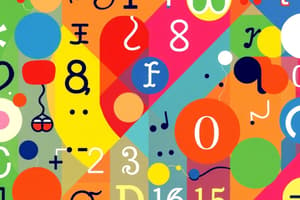Podcast
Questions and Answers
What is required when a different math equation is presented for a program?
What is required when a different math equation is presented for a program?
- Creating a new program (correct)
- Using a universal software framework
- Changing programming languages
- Updating existing programs
Why do computers need preprogrammed software packages?
Why do computers need preprogrammed software packages?
- They can think independently
- To perform tasks automatically
- For people to communicate with them (correct)
- To reduce their processing power
What is the approximate number of lines of code in Windows 10?
What is the approximate number of lines of code in Windows 10?
- 65 million lines (correct)
- 10 million lines
- 100,000 lines
- 1 million lines
Which term is used interchangeably with programmers in the content?
Which term is used interchangeably with programmers in the content?
What aspect of programming languages is compared to the rules of different spoken languages?
What aspect of programming languages is compared to the rules of different spoken languages?
What do most developers typically specialize in?
What do most developers typically specialize in?
What is the main goal of software developers when writing code?
What is the main goal of software developers when writing code?
What must a person do if they want to pursue programming?
What must a person do if they want to pursue programming?
What is assembly language primarily used for?
What is assembly language primarily used for?
What distinguishes assembly code from other programming languages?
What distinguishes assembly code from other programming languages?
In what roles has assembly language been utilized historically?
In what roles has assembly language been utilized historically?
What is a common advantage of using assembly language?
What is a common advantage of using assembly language?
What does a programmer use to translate assembly code into machine code?
What does a programmer use to translate assembly code into machine code?
What binary unit consists of eight bits?
What binary unit consists of eight bits?
Which of the following is a downside of programming in assembly language?
Which of the following is a downside of programming in assembly language?
Why might virus programmers use assembly language?
Why might virus programmers use assembly language?
What are the two distinct states of a conventional light switch?
What are the two distinct states of a conventional light switch?
What is the decimal value of the binary addition 1 + 1?
What is the decimal value of the binary addition 1 + 1?
What decimal values can be represented using one byte?
What decimal values can be represented using one byte?
How does binary counting differ from decimal counting when the value exceeds its limit?
How does binary counting differ from decimal counting when the value exceeds its limit?
Which of the following represents a binary value to decimal conversion for 100?
Which of the following represents a binary value to decimal conversion for 100?
What position in a byte does the leftmost bit represent?
What position in a byte does the leftmost bit represent?
What is the result of adding binary 10 and binary 1?
What is the result of adding binary 10 and binary 1?
What is the value of the binary representation 10010001 in decimal?
What is the value of the binary representation 10010001 in decimal?
What is the primary limitation of standard ASCII?
What is the primary limitation of standard ASCII?
How many characters does Unicode currently support?
How many characters does Unicode currently support?
Which Unicode standard uses 16 bits to allow for 65,536 characters?
Which Unicode standard uses 16 bits to allow for 65,536 characters?
In assembly coding, what is a critical aspect to know regarding the processor?
In assembly coding, what is a critical aspect to know regarding the processor?
What binary code sequence represents the command to move the number 42 into memory register AL?
What binary code sequence represents the command to move the number 42 into memory register AL?
What does the hexadecimal representation B0 2A signify?
What does the hexadecimal representation B0 2A signify?
Which option describes the format of standard ASCII?
Which option describes the format of standard ASCII?
What is one of the challenges involved in coding in assembly?
What is one of the challenges involved in coding in assembly?
What does the mnemonic MOV represent in assembly language?
What does the mnemonic MOV represent in assembly language?
What symbol is used to denote a comment in assembly language?
What symbol is used to denote a comment in assembly language?
Which of the following is a valid programming structure mentioned in the content?
Which of the following is a valid programming structure mentioned in the content?
What is the purpose of the line 'mov eax, 4' in the assembly program provided?
What is the purpose of the line 'mov eax, 4' in the assembly program provided?
What is the typical first program taught in programming classes?
What is the typical first program taught in programming classes?
What does the directive 'global _start' signify in the assembly code?
What does the directive 'global _start' signify in the assembly code?
What is typically the difference between compiled languages and interpreted languages?
What is typically the difference between compiled languages and interpreted languages?
In which section is the message 'Hello, world!' defined in the assembly program?
In which section is the message 'Hello, world!' defined in the assembly program?
What is the first step in creating a program using a compiled language?
What is the first step in creating a program using a compiled language?
Which of the following file extensions is commonly associated with executed compiled programs in Windows?
Which of the following file extensions is commonly associated with executed compiled programs in Windows?
Which of the following programming languages is NOT considered a compiled language?
Which of the following programming languages is NOT considered a compiled language?
What does the syntax of Java use to denote code blocks?
What does the syntax of Java use to denote code blocks?
In the context of writing comments in Java, which of the following is true?
In the context of writing comments in Java, which of the following is true?
Which of the following was commonly used in the past as a compiled programming language?
Which of the following was commonly used in the past as a compiled programming language?
What is the primary function of a compiler in using a compiled programming language?
What is the primary function of a compiler in using a compiled programming language?
What does the source code for 'Hello, world!' in Java print?
What does the source code for 'Hello, world!' in Java print?
Flashcards
Programming Languages
Programming Languages
Different sets of rules and syntax used to give instructions to computers.
Software Development
Software Development
The process of creating and building software applications.
Programming Languages
Programming Languages
Different sets of rules and syntax used to give instructions to computers.
Software
Software
Signup and view all the flashcards
Complexity of Software
Complexity of Software
Signup and view all the flashcards
Programmers/Developers/Coders
Programmers/Developers/Coders
Signup and view all the flashcards
Software titles
Software titles
Signup and view all the flashcards
Computer Instructions
Computer Instructions
Signup and view all the flashcards
Assembly Language
Assembly Language
Signup and view all the flashcards
Assembler
Assembler
Signup and view all the flashcards
Machine Code
Machine Code
Signup and view all the flashcards
Binary System
Binary System
Signup and view all the flashcards
Bit
Bit
Signup and view all the flashcards
Byte
Byte
Signup and view all the flashcards
Processor Architecture
Processor Architecture
Signup and view all the flashcards
Reverse Engineering
Reverse Engineering
Signup and view all the flashcards
Binary System
Binary System
Signup and view all the flashcards
Binary Addition
Binary Addition
Signup and view all the flashcards
Byte
Byte
Signup and view all the flashcards
Bit Position Value
Bit Position Value
Signup and view all the flashcards
Binary to Decimal Conversion
Binary to Decimal Conversion
Signup and view all the flashcards
Decimal System
Decimal System
Signup and view all the flashcards
Bit
Bit
Signup and view all the flashcards
Binary Value 100
Binary Value 100
Signup and view all the flashcards
ASCII
ASCII
Signup and view all the flashcards
Unicode
Unicode
Signup and view all the flashcards
UTF-8
UTF-8
Signup and view all the flashcards
UTF-16
UTF-16
Signup and view all the flashcards
Assembly Language
Assembly Language
Signup and view all the flashcards
Memory Segmentation
Memory Segmentation
Signup and view all the flashcards
Register AL
Register AL
Signup and view all the flashcards
Binary Code
Binary Code
Signup and view all the flashcards
Mnemonic Code
Mnemonic Code
Signup and view all the flashcards
Assembly Command (MOV)
Assembly Command (MOV)
Signup and view all the flashcards
Comment in Assembly
Comment in Assembly
Signup and view all the flashcards
Assembly Structure
Assembly Structure
Signup and view all the flashcards
"Hello, world!" Program
"Hello, world!" Program
Signup and view all the flashcards
Compiled Language
Compiled Language
Signup and view all the flashcards
Interpreted Language
Interpreted Language
Signup and view all the flashcards
Assembly language vs. High-level Languages
Assembly language vs. High-level Languages
Signup and view all the flashcards
Compiled Language
Compiled Language
Signup and view all the flashcards
Source Code
Source Code
Signup and view all the flashcards
Compiler
Compiler
Signup and view all the flashcards
Machine Code
Machine Code
Signup and view all the flashcards
Java Code (Hello, World!)
Java Code (Hello, World!)
Signup and view all the flashcards
Programming Language Syntax
Programming Language Syntax
Signup and view all the flashcards
High-level language (Example: Java)
High-level language (Example: Java)
Signup and view all the flashcards
Executable File (.exe)
Executable File (.exe)
Signup and view all the flashcards
Study Notes
Chapter 6: Software Development
-
Exam Objectives Covered: 1.1 Compare and contrast notational systems, 1.2 Compare and contrast fundamental data types, 4.1 Compare and contrast programming language categories, 4.2 Use programming organizational techniques and interpret logic
-
1.1 Notational Systems:
- Binary (base-2) uses 1s and 0s
- Hexadecimal (base-16) uses 0-9 and A-F
- Decimal (base-10) uses 0-9
- Data representation is crucial in computer science
- ASCII (American Standard Code for Information Interchange) represents characters using numerical codes
- Unicode provides a broader set of characters, including many non-English characters
-
1.2 Fundamental Data Types:
- Char represents one character
- Strings are sequences of characters enclosed in quotes
- Numbers are for numerical data
- Integers are whole numbers
- Floats are numbers with decimals
- Boolean represents true or false values (1 or 0)
-
4.1 Programming Language Categories:
- Interpreted languages run instructions one at a time
- Scripting languages are for automating tasks or quick scripts
- Compiled languages translate entire code into machine code, which runs very quickly
- Query languages are designed to pull information from databases efficiently
-
4.2 Programming Organizational Techniques:
- Organizational techniques are necessary for large programs
- Pseudocode and flowcharts are used to visualize and organize
-
4.3 Programming Concepts:
- Pseudocode and flowcharts as mentioned above allow developers to organize code.
- Identifiers
- Variables
- Constants
- Containers
- Arrays
- Vectors
- Functions
- Objects
- Properties
- Attributes
- Methods
Additional Concepts
- Binary: The base-2 numbering system used by computers (1s and 0s) is essential for understanding how computers process data
- Hexadecimal: A base-16 numbering system frequently used in programming and digital technology, often for representing colors, addressing memory locations, and so on.
- Data Types: Understanding data types (integer, float, string, Boolean, char) is critical when writing programs.
- Programming Languages: This page describes high-level (compiled and interpreted) languages, which are easier to use than assembly (low level), which deals directly with the computer hardware more efficiently.
- Programming Logic: Understanding how programs make decisions (branching, conditional statements) and repeat tasks (loops) is crucial when constructing complex programs. The difference between
if,else if, andelsestatements are part of making complex choices. - Containers: Arrays, vectors, and other structures for storing and managing large amounts of data
- Functions and Methods: Code blocks that perform specific tasks
- Objects and Classes: OOP concepts for grouping data and behavior together
- Organizational Techniques: Flowcharts and pseudocode for planning and visualizing program flow
- Query Languages: Special languages, like SQL, for interacting with data stored in databases
Studying That Suits You
Use AI to generate personalized quizzes and flashcards to suit your learning preferences.




